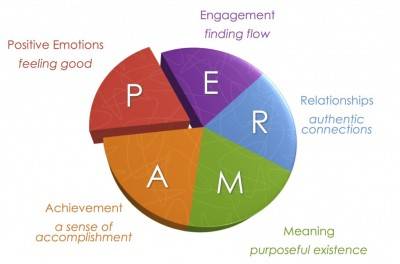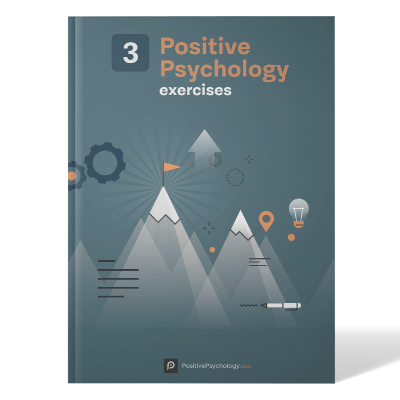Positive Psychology Theory in a Nutshell
 Positive psychology complements traditional psychology’s focus on pathology. It studies strengths, virtues, and the factors that contribute to a full and meaningful life.
Positive psychology complements traditional psychology’s focus on pathology. It studies strengths, virtues, and the factors that contribute to a full and meaningful life.
“Probably the biggest insight is that happiness is not just a place, but also a process. Happiness is an ongoing process of fresh challenges and . . . it takes the right attitudes and activities to continue to be happy.”
– Ed Diener
Martin Seligman, often referred to as the founder of positive psychology, describes it as the scientific study of optimal human functioning that aims to discover and promote the factors that allow individuals and communities to thrive.
Here is a brief overview of positive psychology theory.
This Article Contains:
A Quick Introduction
Before the movement of positive psychology, mainstream psychology focused heavily on the negative aspects of life, such as depression and anxiety (Csikszentmihalyi & Seligman, 2000).
The Diagnostic and Statistical Manual for Mental Disorders (DSM) is a diagnostic manual owned by just about every psychologist in the world. But up until the early 2000s, there was no comparable manual with the systematic classification of positive human traits and values.
In fact, between 1887 and 2001, for every 17 psychology studies related to the topic of negative emotions, there was only one related to positive emotions (Myers, 2015). A few researchers tackled topics like creativity, optimism, and wisdom, but there was no theory or overarching framework uniting them.
Before World War II, psychology had three main missions (Csikszentmihalyi & Seligman, 2000):
- To understand and cure mental illness;
- To improve the lives and productivity of individuals;
- To identify and nurture high talent.
However, given the humanitarian crises in the period following World War II, all available psychology resources were directed toward researching and treating psychological disorders. This is how the field of psychology came to operate within a disease framework. One product of this framework is positive: fourteen psychological diseases that were considered incurable can now be treated.
Nevertheless, the failure to study talents, strengths, and other positive aspects of life left a gap in the field of psychology. Any science that deals with the fundamental questions of human life is incomplete if it only focuses on the negative.
Positive Psychology Theory
Positive psychology was born out of the need to scientifically study the positive aspects of life. The theory of positive psychology has evolved greatly over the last few years—an ever-growing body of research has been uncovering the building blocks of happiness and wellbeing.
Through multiple studies, Martin Seligman found that the extent to which people were aware of and using their signature strengths (for example, courage, persistence, and wisdom) greatly impacted the quality of their lives (Park, Peterson, & Seligman, 2004; Seligman, 2012).
He spent years developing a theory of wellbeing called the PERMA model. The model comprises five elements that create the foundation of a flourishing life (Seligman, 2012; 2018):
- Positive Emotions;
- Engagement;
- Relationships;
- Meaning;
- Accomplishments.
Each of these elements has three properties:
- It contributes to wellbeing;
- People pursue it for their own sakes, not just to attain the other elements;
- It’s measured and defined independently from the other elements.
The PERMA Model In-Depth
Here is a deeper look at each aspect of the PERMA model. It consists of five components:
1. Positive Emotions
Barbara Fredrickson, through her broaden-and-build theory (1998), explains that positive emotions can build our physical, intellectual, and social abilities. She hypothesized that by broadening our awareness and thought-action repertoire, we look for creative and flexible ways of thinking and acting.
Over time, this broadening effect builds skills and resources. Fredrickson’s research shows that people who experience positive emotions make more connections, create more inclusive categories, and have heightened levels of creativity.
Positive emotions also help us perform better at work and strengthen our relationships.
2. Engagement
Flow is an experience of optimal psychological functioning, where we are completely absorbed in a task that slightly exceeds our skill level, and therefore, requires us to stretch to a new level of performance.
“The best moments in our lives are not the passive, receptive, relaxing times . . . The best moments usually occur if a person’s body or mind is stretched to its limits in a voluntary effort to accomplish something difficult and worthwhile.”
– Mihaly Csikszentmihalyi (1990, p. 3)
When experiencing flow, concentration becomes so laser-focused that everything else seems to disappear and perception of time is altered.
The incessant voice in our head also quiets down when experiencing flow. Research shows that the prefrontal cortex, the area of the brain responsible for cognitive processes such as self-reflection and self-consciousness, shows less activation during states of flow (Dietrich, 2003). The result is a heightened level of performance and creativity.
Mihaly Csikszentmihalyi, the researcher who coined the term “flow,” believes happiness isn’t something that simply happens. Instead, Csikszentmihalyi (1990) says it’s the product of an individual facing challenges that are neither too demanding nor too simple for one’s abilities.
3. Relationships
As humans, we are hardwired to connect with others. We have a need for connection, love, and physical and emotional proximity to others.
The need for connection begins at birth–human babies depend on others to care for them because they are unable to survive on their own. In addition, humans develop and learn about life and navigating the world through interactions with other people and the perspectives they offer.
It might not come as a surprise, then, that studies have repeatedly shown that the one thing that sets happier people apart is the quality of their relationships.
Psychiatrist Robert Waldinger is behind one of the longest and most-complete studies of adult life. The study followed two cohorts of men for 75 years, starting in 1938. These men answered surveys every two years about the quality of their marriages, job satisfaction, and social activities. Every five years, researchers examined the subjects’ physical health.
The study had one question to answer, What keeps us happy and healthy? The results revealed a simple answer: good relationships.
Christopher Peterson summed this up nicely with his quote:
“Other people matter.”
4. Meaning
Seligman argues that one’s level of wellbeing is affected by choices, attitudes, and behaviors. He states, however, that there are no shortcuts. Wellbeing takes effort and persistence.
And while positive emotions are necessary to a healthy life, fostering a deeper, more enduring sense of wellbeing requires an exploration of meaning.
Martin Seligman defines meaning as “using your signature strengths and virtues in the service of something much larger than you are” (Seligman, 2002, p. 249).
He states that authentic happiness is:
“A preface to the meaningful life and that while it is possible take drugs to generate the effects of positive emotion and pleasure through pharmacology, it is not possible to synthesize the positive effects of being in the flow or of experiencing meaning.”
When we only chase pleasure for its own sake and fail to use our strengths toward something meaningful, we might squander our potential. But when we apply and develop our unique strengths and virtues toward something bigger than ourselves, we experience a deeper sense of satisfaction.
5. Accomplishments
Studies consistently show that people who feel personally involved in achieving their goals indicate higher levels of wellbeing and are in better health than people who lack a sense of direction in their lives.
Nevertheless, not all goals contribute equally to wellbeing. Research shows that goals that lead to wellbeing are personally meaningful.
In the early 1960s, Seligman was working in Professor Byron Campbell’s lab at Princeton University. At that time, the prevailing theory of motivation was drive-reduction theory, which states that all animals act based on the need to satisfy their biological needs.
However, in 1959, Robert White published an article titled “Motivation reconsidered: the concept of competence,” which went against drive-reduction theory. In it, he argued that rather than just satisfying biological needs, people and animals often acted for the sake of mastery over their environments.
Seligman found this to be true. We often pursue accomplishment for its own sake, even if it doesn’t translate into an increase in positive emotions, meaning, or the quality of relationships.
So how do we shift our perspective to incorporate these other aspects that help humans thrive?
A Brief Summary
Seligman explains how with positive psychology and his holistic study of happiness, he is:
“[…] trying to broaden the scope of positive psychology well beyond the smiley face. Happiness is just one fifth of what human beings choose to do.”
– Martin Seligman
How can you apply the PERMA model to your personal or work life? Have you had success or struggles with it before?
We would love to hear your experience in our comments section below.
- Csikszentmihalyi, M. (1990). Flow: The psychology of optimal experience. Harper & Row.
- Csikszentmihalyi, M., & Seligman, M. E. P. (2000). Positive psychology. American Psychologist, 55(1), 5-14.
- Dietrich, A. (2003). Functional neuroanatomy of altered states of consciousness: The transient hypofrontality hypothesis. Consciousness and Cognition, 12(2), 231-256.
- Fredrickson, B. L. (1998). What good are positive emotions? Review of General Psychology, 2(3), 300-319.
- Myers, D. G. (2015) Emotions, stress, and health. In D. G. Myers (Ed.), Psychology (11th ed.). Scott-Foresman.
- Park, N., Peterson, C., & Seligman, M. E. (2004). Strengths of character and well-being. Journal of Social and Clinical Psychology, 23(5), 603-619.
- Schultheiss, O. C., & Brunstein, J. C. (1999). Goal imagery: Bridging the gap between implicit motives and explicit goals. Journal of Personality, 67(1).
- Seligman, M. E. P. (2012). Flourish: A visionary new understanding of happiness and well-being. Simon & Schuster.
- Seligman, M. E. P. (2018). PERMA and the building blocks of well-being. The Journal of Positive Psychology, 13(4), 333-335.
- White, R. W. (1959). Motivation reconsidered: The concept of competence. Psychological Review, 66(5), 297 333.
Let us know your thoughts
Read other articles by their category
- Body & Brain (41)
- Coaching & Application (49)
- Compassion (27)
- Counseling (46)
- Emotional Intelligence (23)
- Gratitude (16)
- Grief & Bereavement (19)
- Happiness & SWB (35)
- Meaning & Values (26)
- Meditation (21)
- Mindfulness (42)
- Motivation & Goals (42)
- Optimism & Mindset (33)
- Positive CBT (24)
- Positive Communication (21)
- Positive Education (41)
- Positive Emotions (28)
- Positive Psychology (33)
- Positive Workplace (38)
- Relationships (31)
- Resilience & Coping (33)
- Self Awareness (21)
- Self Esteem (38)
- Software & Apps (23)
- Strengths & Virtues (28)
- Stress & Burnout Prevention (27)
- Theory & Books (42)
- Therapy Exercises (30)
- Types of Therapy (53)





What our readers think
I absolutely love this, thank you.
Definitely interested in this as it completes the overall experience of psychological well being. Maybe governments around the world could study this and look at ways to implement it into society.